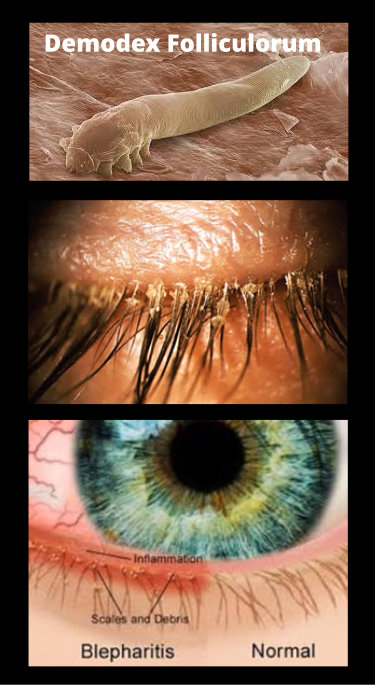
Blepharitis is a common eye condition characterized by eyelid margin inflammation causing irritation and dry eye symptoms. Blepharitis is associated with staphylococcal infection and seborrhoeic dermatitis. Demodex blepharits is a less well-known type of this chronic condition, caused by the Demodex mite. Conventional treatment for blepharitis, which include regular warm compresses followed by lid scrubs can aid in cleaning the eyelid margins but it is not toxic to the mites so it does not bring the desired relief for patients affected by Demodex blepharitis.
Demodex mites infest the follicles and sebaceous glands of most mammals. All adults have some mites, but when there is an overpopulation of mites, they cause trouble, including blepharitis. There are two types of mites, Demodex Folliculorum and Demodex Brevis. Demodex Folliculorum lives in human lash follicles and feeds on sebum (oil) and epithelial cells. They measure approximately 0.4 mm in length, have eight legs ending in claws and are quite transparent. They have a total lifespan of about twenty days. Demodex Brevis is approximately 0.2 mm long and live in the meibomian glands. They rely on meibum as a food source. Studies show that Demodex infestation, as well as blepharitis, is also associated with Meibomian gland dysfunction.
The prevalence of the mites on the skin increases with age. Not all patients who carry the mites suffer any symptoms, and they can be found in most adults. It is believed that good hygiene helps to prevent infestation, and it has been shown that patients who wear makeup are less likely to have Demodex on their skin. Considering the eye area is harder to keep clean than the rest of the face, this increases the chance of infestation on the lids.
There is a well-known association between rosacea and blepharitis. The suppressed immunity associated with rosacea may lead to increased risk of mite infestation. Long term use of topical steroids suppresses the immune response, thus allowing the mites to thrive. Diabetes is also thought to be associated with an increased susceptibility to Demodex.
Symptoms for Demodex blepharitis are similar to those of the other types of blepharitis and dry eye, namely itching and burning, red lids, blurred vision, with a failure to respond to conventional treatments. Demodex mites are sensitive to light so they are most active at night. In the mornings as the light returns the mites crawl back into the lash follicle, causing itching and irritation. Therefore, symptoms caused by Demodex are often worse at night and on waking. Eyelashes infested with Demodex are often brittle and easily pulled out. Loss of lashes can occur in patients suffering from Demodex blepharitis. Small crusts called cylindrical dandruff can be seen at the base of the lashes.
Treatment
The aim of treatment is to reduce the population of mites. General improvement in hygiene and body washing will help. Tea tree oil has been shown to readily kill mites. Patients can use tea tree oil shampoo and body wash, as the mites are likely to be elsewhere on the body too.
Heat kills the mites and it is recommended that bedding and towels are washed and dried on a high heat setting in the tumble drier on a weekly basis. All old make-up should be discarded.
The eyelid margins should be cleaned daily. Sterilid, Blephadex Eyelid Foam and Blephadex Eyelid Wipes all contain tea tree oil which is effective in the treatment and management of Demodex blepharitis.
In some patients, a course of intensive tea tree oil eyelid scrubs may be required to kill the mites and to interrupt their life cycle. This inhouse treatment is offered by some optometry and ophthalmology practices. Tea tree oil in concentrations required to kill the mites is toxic to the ocular surface and needs to be applied in a controlled practice environment. Ask your optometrist or ophthalmologist for advice and treatment options.
*References available on request
